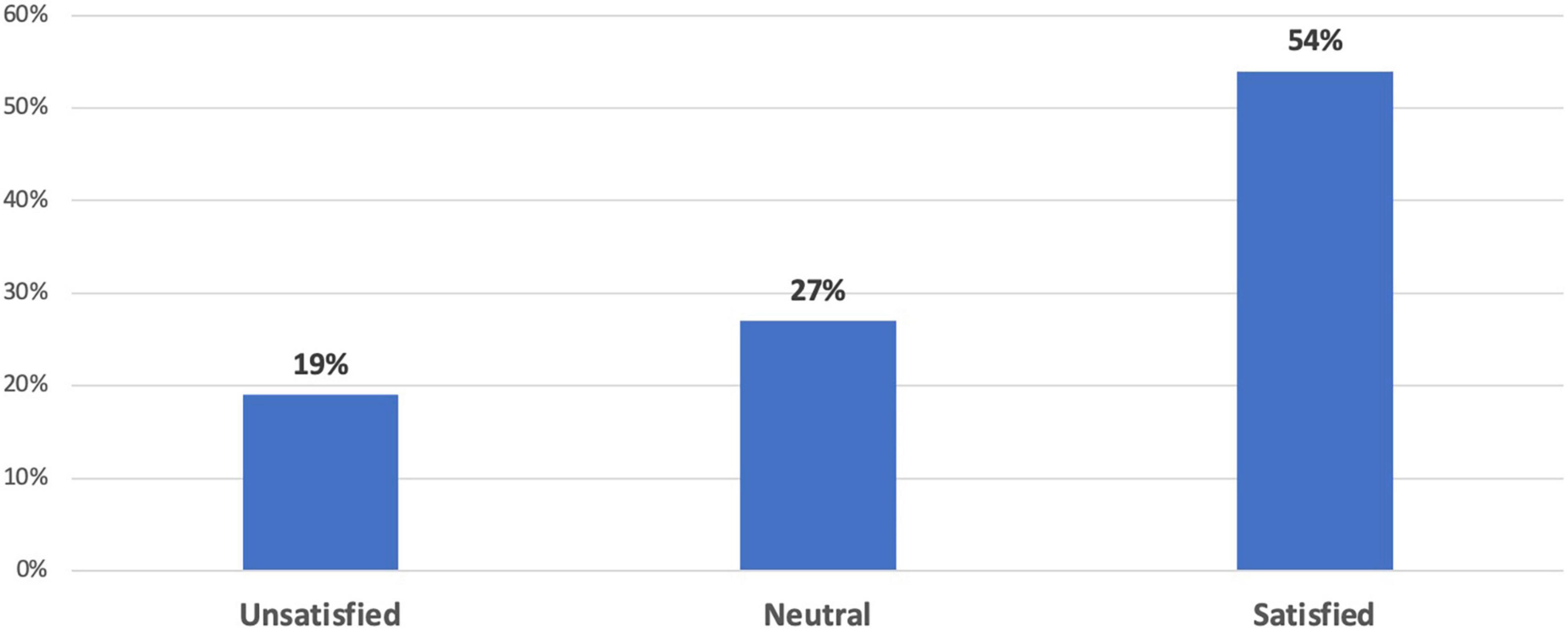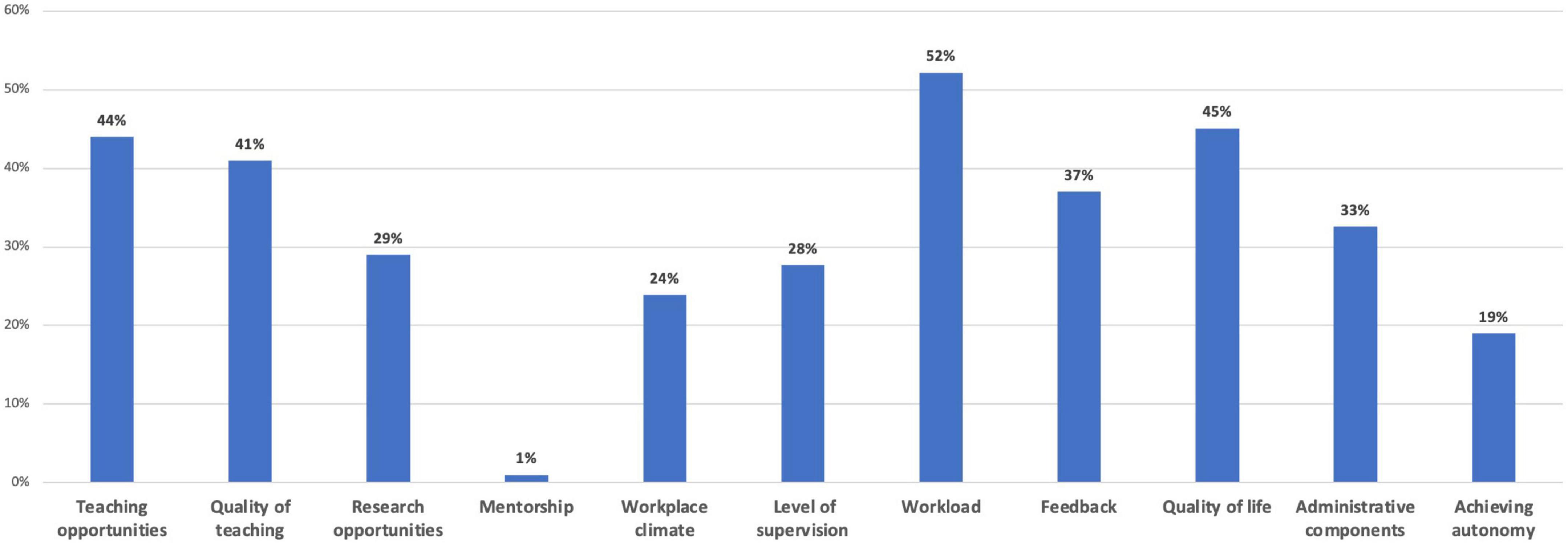- 1College of Medicine, King Saud Bin Abdulaziz University for Health Sciences, Riyadh, Saudi Arabia
- 2King Abdullah International Medical Research Center, Riyadh, Saudi Arabia
- 3Internal Medicine, King Khalid University Hospital, Riyadh, Saudi Arabia
- 4Department of Biostatistics, Epidemiology, and Environmental Health Sciences, Jiann-Ping HSU College of Public Health, Georgia Southern University, Statesboro, Georgia
- 5Internal Medicine, King Abdulaziz Medical City, Riyadh, Saudi Arabia
Background: The Saudi Internal Medicine (IM) residency program is a 4-year training program that qualifies competent physicians to provide optimal healthcare services. Residents’ satisfaction is a key indicator for a program effectiveness in preparing well-trained physicians. However, no national studies have investigated the perspective of IM residents. This study assessed IM resident’s satisfaction regarding the residency program in several training centers.
Methods: A cross-sectional study with 194 enrolled IM residents was conducted between November 2022 and June 2023 at multiple governmental hospitals in the central region of Saudi Arabia. Data collection was done via an electronic questionnaire. The satisfaction rate was interpreted by a five-point Likert scale (1 “completely unsatisfied” to 5 “extremely satisfied”).
Results: Out of the 184 responses, residents aged 25–27 years comprised 122 (66%) of the sample with male participants being the highest in number at 109 (59%) which was highly significant in accordance to the level of satisfaction (χ2 = 10.07, p = 0.006). Additionally, 89 (54%) junior residents was found to have a significant satisfaction compared to senior residents. In total, 112 (61%) of residents would choose the same IM residency program again if they had the chance and expressed a better level of satisfaction (χ2 = 101, 28, p < 0.001). Overall, the percentage of satisfied residents was around half of the sample 100 (54%). However, workload, quality of life, and teaching opportunities were among the most frequently chosen areas for improvement.
Conclusion: The study concluded that 54% of IM residents were highly satisfied with the program in their respective training center. However, residents have excessive workload, reduced quality of life, and differing unmet learning needs.
Introduction
The Saudi Internal Medicine (IM) residency program is a 4-year training program in internal medicine and it’s subspecialties including emergency medicine and critical care. It is an evidence-based, multidisciplinary program that qualifies competent physicians to provide optimal healthcare status (Saudi Commission for Health Specialties-Home, 2023). The Saudi IM residency curriculum follows the Canadian Medical Education for Directors and Specialists (CanMEDS) framework. It ensures the application of the seven CanMEDS pillars: medical expert, communicator, collaborator, manager, health advocate, scholar, and professional. The framework has also recommended the implantation of teaching and learning activities including morning reports, grand rounds, journal clubs, joint specialty meetings, and academic half days for better training outcomes (Royal College of Physicians and Surgeons of Canada, 2023). At the end of the academic year, trainees are required to go through certain assessments including a written multiple choice question examination and an objective structured clinical examination.
Acknowledging the impact of a residency program on cultivating well-trained physicians, studies have examined residents’ satisfaction as a predictor of the overall program’s efficacy and success (Al Shanafey et al., 2009; Aldossary et al., 2019). A recent study conducted in the Eastern Province of Saudi Arabia revealed that 44.6% of general surgery residents were dissatisfied with the quality of their program, leading 20.5% to pursue alternative training opportunities. Their dissatisfaction stemmed from the limited case volume, research opportunities, and mentorship (Aldossary et al., 2019). Similarly, the dissatisfaction rates among plastic surgery trainees reached 61%, signaling potential risks to the integrity of the provided care (Al Qurashi et al., 2022). Concerns arise regarding the potential implications of such dissatisfaction. Residents who are not wholly committed to their training may quit before completing their residency or under-deliver patient care due to a lack of engagement or burnout (Eckleberry-Hunt et al., 2009). Conversely, higher rates of satisfaction were reported amongst Saudi trainees in the pediatric surgery residency program, suggesting that some programs effectively foster the well-being and professional growth amongst their residents (Altokhais et al., 2020). Such findings emphasize the critical need to prioritize well-being measures and reevaluate the training programs (Van der Leeuw et al., 2012).
Given the pivotal role that resident satisfaction plays as a key indicator of program success, there was an imminent need to conduct this inquiry. Thus far, the academic literature lacks comprehensive national studies offering the perspective of IM residents regarding their respective training curricula. The aim of this research, therefore, is to evaluate IM resident’s satisfaction across various educational establishments in Riyadh, Saudi Arabia.
Materials and methods
Study settings and participants
A cross-sectional survey study was conducted between November 2022 and June 2023 and included IM residents enrolled at multiple governmental tertiary care hospitals in Riyadh, Saudi Arabia: King Abdul-Aziz Medical City (KAMC), King Khalid University Hospital (KKUH), King Faisal Specialist Hospital and Research Center (KFSH-RC), and King Fahad Medical City (KFMC). The Saudi board program is directed by the Medicine Residency Training Program Committee and is accredited as an official residency training program by the Saudi Commission for Health Specialties (SCHS). It involves 4 years of a comprehensive supervised training designed to help residents evolve from their initial junior years - first 2 years - to their advanced senior levels - final 2 years. Upon completion of the program, residents are awarded the “Saudi Board in IM” certificate (Saudi Commission for Health Specialties-Home, 2023). For the study, the population targeted comprised all IM residents undergoing training in the selected healthcare facilities for the academic year 2022–2023 and who had completed a minimum of 3 months of their training. Notably, we excluded rotators from other specialties, board-eligible residents, and those who opted not to participate. Keeping the margin of error at 5%, confidence level at 95%, and a 50% response distribution with a population size of 400 participants, the optimal estimated sample size was approximately 197. For the inclusion of the study subjects, the research team used a non-probability convenience sampling technique.
Data collection tool
Data were collected through a validated questionnaire previously implemented in a comprehensive, nationwide study assessing the satisfaction of Saudi board plastic surgery residents with their training program (Al Qurashi et al., 2022). The survey was revised by three consultants in the field of IM, and minor modifications were applied as needed to ensure its objectivity and suitability to the current study’s objectives. After displaying the study’s aims and obtaining informed consent, participants were required to answer demographic questions before proceeding to the main survey items. The questionnaire involved three sections covering general program characteristics, theoretical and medical education, and future vision, recommendations, and satisfaction rate. The electronic version of the survey was disseminated to trainees via a web-based Google Docs. Residents’ satisfaction was assessed using the question: “How would you rate your overall satisfaction regarding your Saudi board of IM residency program?” The responses were measured on a five-point Likert scale ranging from 1 (“completely unsatisfied”) to 5 (“extremely satisfied”).
Statistical analysis
Initially, Microsoft Excel sheets were utilized for data entry and coding purposes. All the data was checked by team members to ensure proper coding and then was transferred to the Statistical Package for the Social Sciences (SPSS) software version 24 for further statistical analysis. Descriptive statistics for Likert scale items were presented as frequency distribution and percentages. Furthermore, the five-point Likert scale pertaining to different domains of satisfaction was later categorized into three groups. Those who selected a rating of 1 or 2 were categorized as unsatisfied while those who chose a rating of 4 or 5 were categorized as satisfied. The remaining ratings of 3 were considered neutral (Al Qurashi et al., 2022). To assess the association of residents’ satisfaction across different domains of the satisfaction, chi-square test was applied. Statistical significance was set at p-value of 0.05. No identifiers were required, and all collected data were kept under lock and key with authorized access only.
Results
Demographic characteristics
A total of 184 responses were collected. Residents aged 25–27 years comprised 122 (66%) of the sample, with junior residents being the highest in number at 98 (54%). Male participants represented 109 (59%) which was found highly significant in accordance to the level of satisfaction (χ2 = 10.07, p = 0.006). Majority of residents 149 (81%) were single/not married. When asked about the time spent commuting to work, 114 (62%) reported almost 30 min or less, while the remaining 70 (38%) traveled >30 min. The variables including residency training year and commuting duration had a significant association with the perceived level of satisfaction with (χ2 = 14.33, p = 0.026), (χ2 = 8.46, p = 0.015), respectively (Table 1).
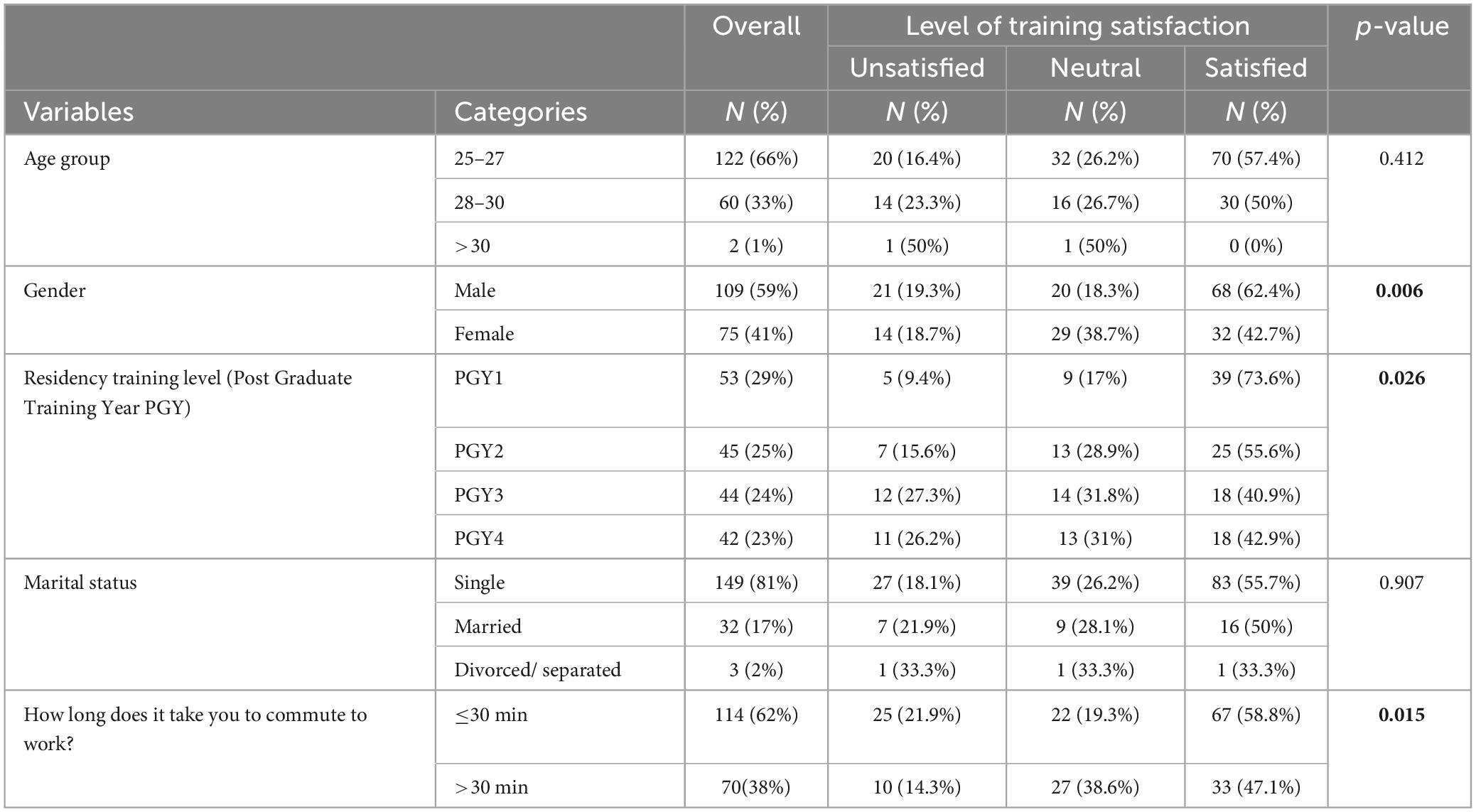
Table 1. Residents’ sociodemographic characteristics in accordance with the overall satisfaction regarding Saudi board IM residency program (n = 184).
General program characteristics
The highest number of responses were received from KAMC trainees 63 (34%). When measuring the level of perceived satisfaction in each centers, a significant association was found (χ2 = 24.54, p < 0.001). There was an equal representation of satisfied and unsatisfied trainees at KAMC 24 (38.1%). However, the majority of trainees from other centers were satisfied; KKUH 30 (61.2%), KFSH-RC 26 (63.4%), KFMC 20 (64.5%). Most participants reported that their average working hours is not exceeding 80 h per week 150 (81%) with an equal to or less than 4 overnight call shifts per month 109 (59%). Furthermore, PGY1 was highly chosen as the most clinically demanding year in the program 146 (79%). Around 69 (38%) participants agreed that their residency training program uses their feedback constructively, of which a great proportion were significantly more satisfied (χ2 = 86.87, p < 0.001). In total, 112 (61%) of residents would choose the same IM residency program again if they had the chance and expressed a better level of satisfaction (χ2 = 101, 28, p < 0.001) (Table 2).
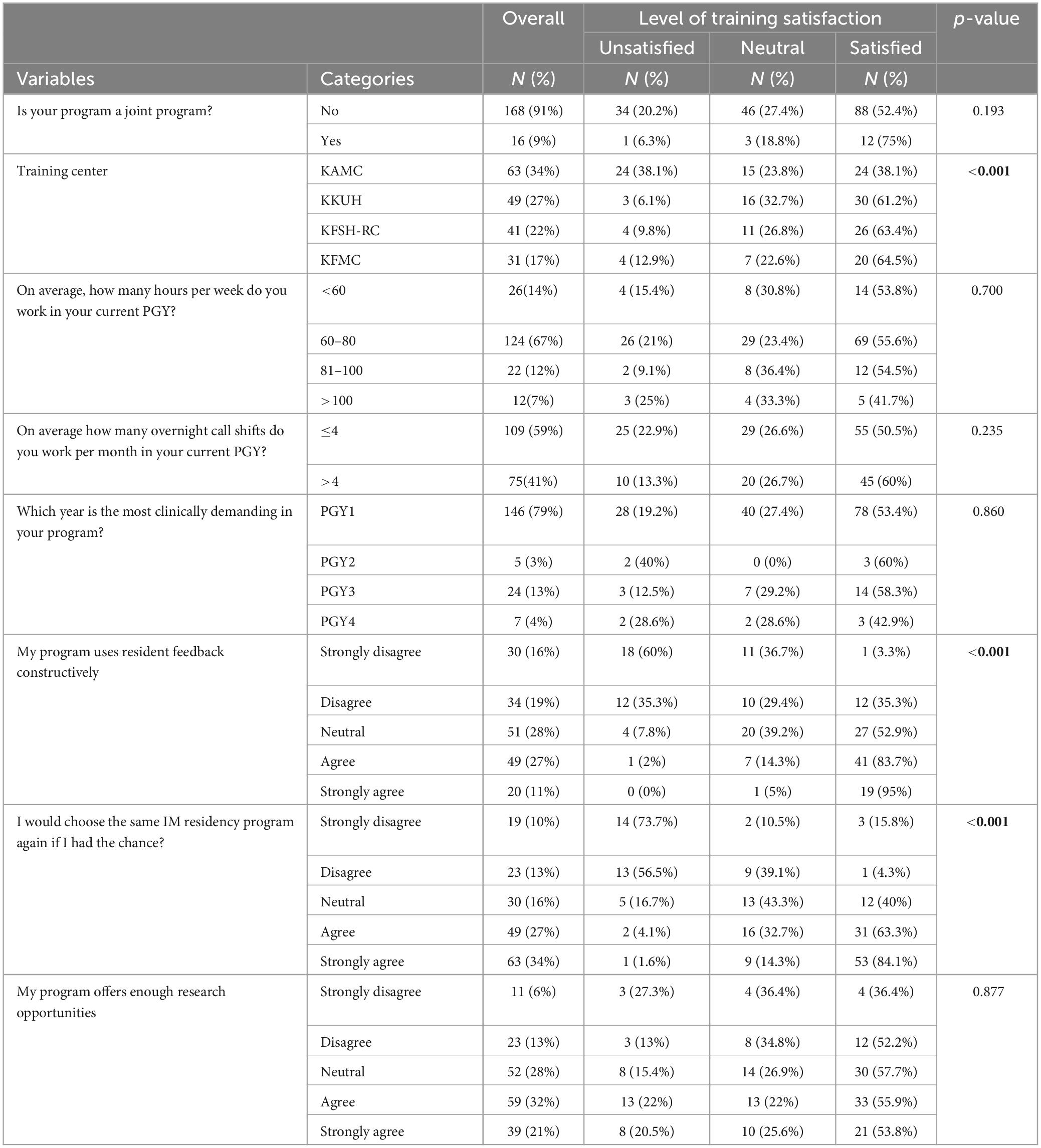
Table 2. General program characteristics in accordance with the overall satisfaction regarding Saudi IM residency program (n = 184).
Theoretical and medical education
When assessing the satisfaction about the educational curriculum of the program, those who responded with “not at all” 56 (30%) were found to be significantly unsatisfied (χ2 = 80.55, p < 0.001). Those who encountered difficulty in understanding IM related topics 15 (8%) reported higher levels of dissatisfaction (χ2 = 9.56, p = 0.048). On the other hand, a significant satisfaction was found among trainees who believed that teaching activities were beneficial 88 (48%) and benefited from round discussion 111 (60%) (χ2 = 58.53, p < 0.001) (χ2 = 40.38, p < 0.001), respectively. The majority of participants who attend two or more teaching activities per week were more satisfied with the program (χ2 = 12.66, p < 0.001). Similarly, those who have a mentor available to help them expressed a better satisfaction 114 (62%) (χ2 = 56.83, p < 0.001) (Table 3).
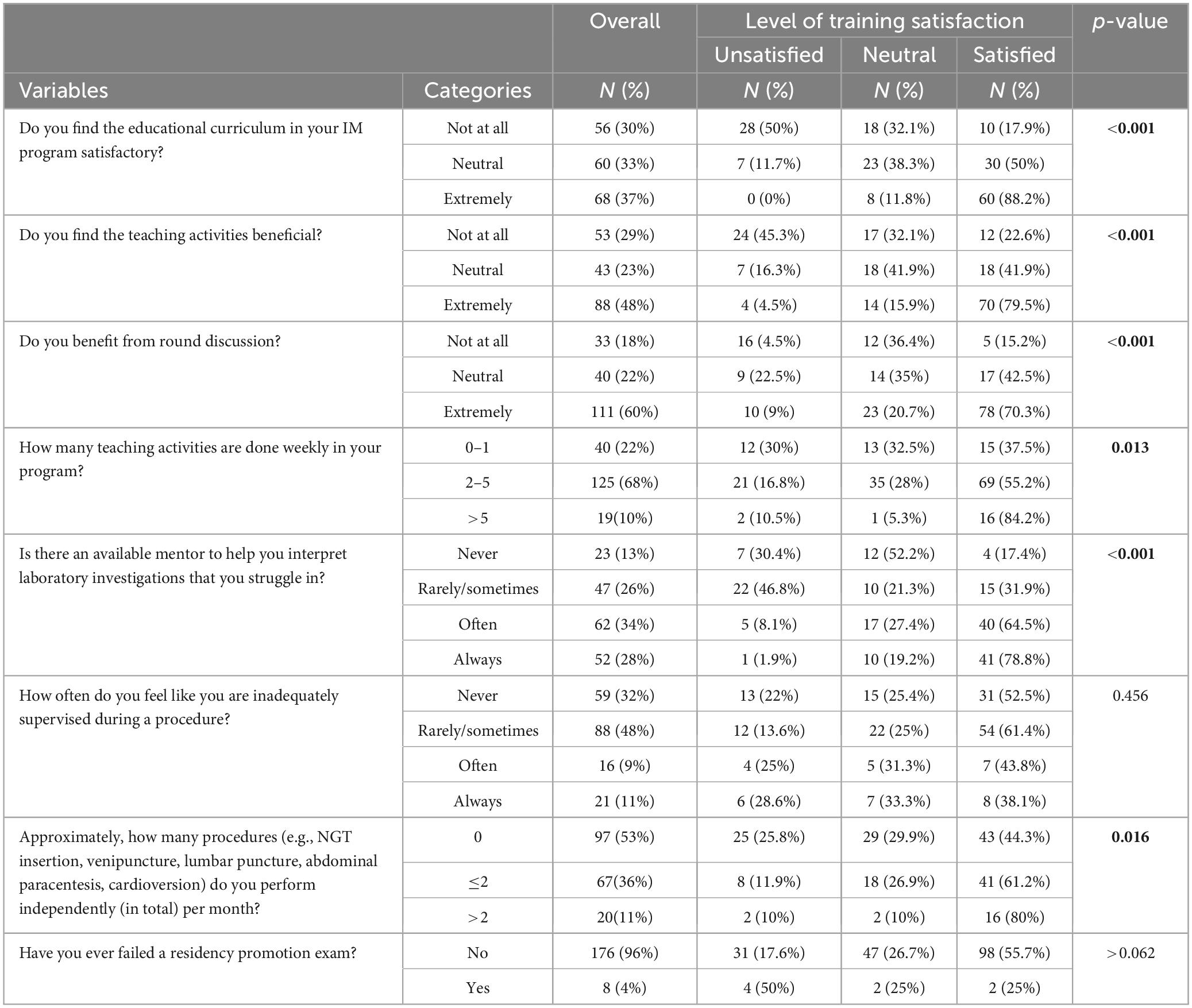
Table 3. Theoretical and medical education in relation to the overall satisfaction regarding Saudi Board IM residency program (n = 184).
Residents’ perception in relation to the overall satisfaction
According to the findings, 102 (55%) residents were satisfied with the current case volume and expressed a significantly higher satisfaction toward the program (χ2 = 36.67, p < 0.001). A small percentage 15 (8%), however, indicated that they would like to be more involved in work to achieve a higher level of satisfaction. Almost half of the residents 89 (48%) suggested that increasing the number of residents would help to reduce the daily workload (Table 4).
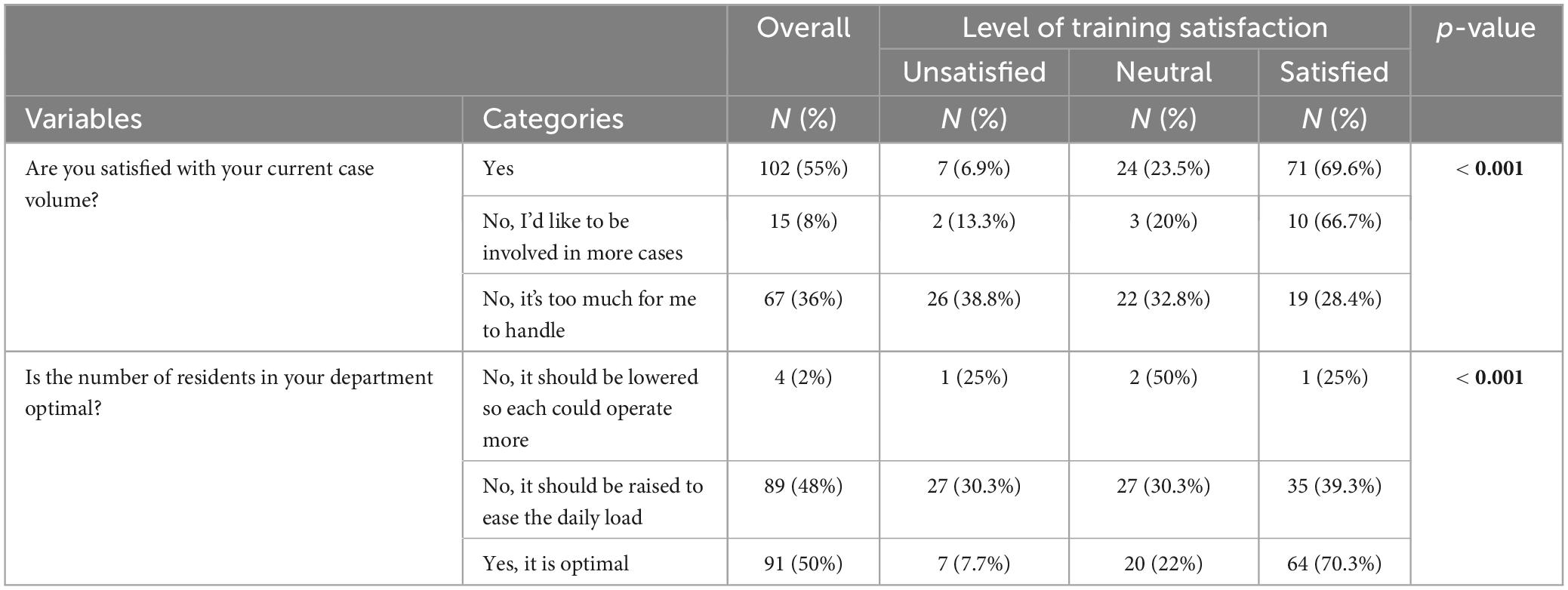
Table 4. Residents’ perception in relation to the overall satisfaction regarding Saudi board IM residency program (n = 184).
Satisfaction level and areas for improvement of the program
Overall, our study concluded that 100 (54%) residents were generally satisfied, whereas 35 (19%) residents indicated their dissatisfaction regarding their current training program. The remaining 49 (27%) expressed a neutral answer. Additionally, when asked to suggest areas for improvement, workload, quality of life, teaching opportunities, and quality of teaching were the most frequently chosen aspects (Figures 1, 2).
Discussion
Our research was conducted to investigate the perceived level of satisfaction of IM residents with the current training program with special attention paid to assess predictors of satisfaction, measure the quality of the IM training program, and identify local training needs for improvement purposes. Additionally, the association of program and participants’ characteristics with the perceived satisfaction was considered during the research. Results showed that the overall satisfaction level was higher among males compared to females which could be attributed to the fact that the majority of respondents were males. Surprisingly, first year residents had a significantly higher satisfaction score even though it’s reported to be the most demanding year. This may be explained by the focused educational activities, close supervision, and frequent feedbacks given during this level. As residents progress through training, however, they become burdened with an excessive workload along with heavier responsibilities and therefore have a more critical view of program quality. Commuting time is also an important factor of job satisfaction since time burden is associated with burnout consequences and deteriorating mental health leading to career dissatisfaction (Cohen and Patten, 2005).
According to our data, the majority of participants were generally satisfied with the program except for KAMC trainees who displayed equal percentages of satisfaction and dissatisfaction. An acceptable reason behind this is the increased clinical demands encountered at KAMC since. it provides all levels of care to eligible national guard patients including Saudi military personnel and their eligible dependents, an estimate increasing with time (Ministry of National Guard Health Affairs [MNGHA], 2023; Armed forces personnel, total - Saudi Arabia, The World Bank, 2023). Furthermore, KAMC extends its healthcare services to include non-member citizens who fit its eligibility criteria (Ministry of National Guard Health Affairs [MNGHA], 2023). This would impose a heavier workload burden and long working hours as reported by our participants. This is consistent with Cohen and Patten (2005) findings, which suggested that an excessive workload, among other factors, was associated with less career satisfaction among French IM physicians and residents (Cohen and Patten, 2005).
One of the notable findings was the higher satisfaction associated with using residents’ feedback constructively. A similar study in the United States showed similar results with regards to a better level of satisfaction and a positive sentiment toward radiation oncology training program when incorporating periodic feedback (Ahmed et al., 2018). It is well established that having a thoughtful intentional approach to feedback would result in a significant developmental progression of the training program and provide trainers with their learning needs in order to achieve competence throughout the residency program (Atkinson et al., 2022). Consequently, this would improve the program quality and will be reflected on its trainees’ satisfaction level (Susanne et al., 2006; Atkinson et al., 2022). Overall, more than half of the study subjects indicated that they would choose the same training program again if they had the chance. This is consistent with the findings of a recently published Swiss study measuring the well-being of its general IM residents. It revealed that only about 20% of residents had a career choice regret and the wish to leave the clinical practice (Zumbrunn et al., 2020).
Around one third of participants were unsatisfied with the residency curriculum. It is hypothesized that ineffective curriculum development in terms of irrelevant content to the practice, not engaging residents, and unsuccessful curriculum execution could contribute to their dissatisfaction (AlShareef, 2014; Alkhamees et al., 2021). Moreover, a higher number of teaching activities per week seems to be associated with a notable level of satisfaction which was also observed among Stanford IM residents indicating that active learning is a preference among residents (Kahn et al., 2017). An interesting finding was that mentorship and clinical case exposure played a major role in the overall training experience. This was reinforced by the results of a study in Qassim assessing satisfaction of family medicine residents who were highly satisfied with mentoring in the form of supervision and feedback (Rabbani et al., 2020). Therefore, mentorship requires additional evaluation, and residents’ point of view should be taken into consideration to help improve and sustain their satisfaction and learning process.
As our results demonstrated, heavier workload burden amongst residents can be attributed to the long working hours and case volumes as seen in Tables 2, 4. These are important factors in determining the satisfaction as mirrored in various studies (Copeland et al., 2022; Kejela and Tiruneh, 2022). It was suggested that an increased number of inpatients under trainee physicians care can mitigate burnout and stress in residents (Thomas, 2004; Zhou et al., 2020). Alenezi et al. (2022) has comprehensively measured the prevalence and associated factors of burnout among 426 residents in Medina, Saudi Arabia through the use of the Maslach Burnout Inventory-Human Services Survey (MBI-HSS) assessment tool. It was found that IM residents along with pediatric residents experienced higher rates of burnout compared to those from family medicine and preventive medicine (Alenezi et al., 2022). Burnout in healthcare workers can lead to decreased quality of care, thus compromising overall quality of life and leading to less career satisfaction (Tawfik et al., 2019).
As was reported previously, the unmet learning needs highlighted by our participants can be explained by the inadequate number of teaching activities, few clinical procedures performed, and the lack of instructions received from attending physicians. It was implicated in a previous study that residents of different training levels have demonstrated different perceptions and expectations of the learning environment, hence maintaining flexible training programs through which residents are allowed to choose more relevant teaching activities suiting their level of experience is much needed (Ong et al., 2020). Furthermore, recent research has indicated a decline in bedside rounds which remains an integral part of clinical setting learning, yet given time constraints and workload, bedside teaching quantity has decreased (Purcell et al., 2022; Ratelle et al., 2022; Ahmed et al., 2023).
Despite the comprehensiveness of this study, our approach was not devoid of certain limitations. The reporting bias, as in all surveys, may have affected the overall satisfaction. Since only four institutions are involved in the study, it can limit the generalizability of our results to other training hospitals. However, our study included some of the major training centers in the central region, hence we believe that our sample is representative of such hospitals. It is important to highlight that the survey was based solely on questions related to the program. To address this limitation, further qualitative research should consider integrating a wider array of assessment tools, such as interviews or focus groups to further explore participants’ perspectives and suggestions. This addition would offer a more holistic insight into the program’s impact and guide future improvements and adjustments. Nevertheless, our data can provide meaningful insight for IM residency program directors and the Saudi Commission for Health Specialties (SCFHS). Considering that patient care is directly influenced by the quality of physician training, the advancements in residency training program is integral to achieving the healthcare excellence. Healthcare institutions uphold the responsibility to optimize working conditions and ensure adequate staffing to minimize the workload and burnout risks. Increasing the number and quality of teaching activities, and frequently assessing and reconstructing the curriculum are of paramount importance as it is correlated with higher satisfaction. Future research should include all Saudi IM residents to further explore institutional satisfaction and identify other predictors for improving satisfaction among residents.
Conclusion
The study concludes that 54% of IM residents are highly satisfied with the program in their respective training center. However, the majority of them highlighted areas of weaknesses that need to be addressed and improved upon. Responses frequently indicated that workload, quality of life, teaching opportunities, and quality of teaching were areas to be in most need of improvement. Given the human and financial costs of residents’ burnout on their well-being and the quality of care provided, focusing on areas of improvement with greatest impact could serve as a base toward an efficient residency program with higher training satisfaction.
Data availability statement
The raw data supporting the conclusions of this article will be made available by the authors, without undue reservation.
Ethics statement
The studies involving humans were approved by the King Abdullah International Medical Research Center, Riyadh, KSA. The studies were conducted in accordance with the local legislation and institutional requirements. The participants provided their written informed consent to participate in this study.
Author contributions
NA: Conceptualization, Data curation, Methodology, Writing – original draft, Writing – review and editing. SA: Conceptualization, Data curation, Methodology, Writing – original draft, Writing – review and editing. RA: Conceptualization, Data curation, Methodology, Writing – original draft, Writing – review and editing. FA: Conceptualization, Data curation, Methodology, Writing – original draft, Writing – review and editing. OA: Conceptualization, Data curation, Methodology, Writing – original draft, Writing – review and editing. HK: Conceptualization, Data curation, Methodology, Writing – original draft, Writing – review and editing. NM: Data curation, Formal analysis, Methodology, Software, Supervision, Validation, Writing – original draft, Writing – review and editing. JA: Conceptualization, Data curation, Methodology, Resources, Supervision, Validation, Writing – original draft, Writing – review and editing.
Funding
The author(s) declare that no financial support was received for the research, authorship, and/or publication of this article.
Acknowledgments
We wish to acknowledge all the residents for their valuable contribution to this study, as well as all IM residency program directors of the involved training centers for their administrative efforts in this project.
Conflict of interest
The authors declare that the research was conducted in the absence of any commercial or financial relationships that could be construed as a potential conflict of interest.
Publisher’s note
All claims expressed in this article are solely those of the authors and do not necessarily represent those of their affiliated organizations, or those of the publisher, the editors and the reviewers. Any product that may be evaluated in this article, or claim that may be made by its manufacturer, is not guaranteed or endorsed by the publisher.
References
Ahmed, A., Ramey, S. J., Dean, M. K., Yoo, S. K., Holliday, E., Deville, C., et al. (2018). Resident satisfaction with radiation oncology training. Adv. Radiat. Oncol. 3, 234–239. doi: 10.1016/j.adro.2018.03.003
Ahmed, H., King, A. B., Mohamed, N., Mokaya, E., Chapman, K., and Leonard, R. (2023). Perception versus reality: Analysis of time spent on bedside rounds in an academic ICU (Intensive Care Unit). BMC Med. Educ. 23:274. doi: 10.1186/s12909-023-04243-y
Al Qurashi, A., Mortada, H., Alrobaiea, S., Abuthiyab, N., Al Zaid, N., Betar, M., et al. (2022). Satisfaction of Saudi board plastic surgery residents with the training program: A national survey. Plast. Reconstr. Surg. Glob. Open 10:e4071. doi: 10.1097/GOX.0000000000004071
Al Shanafey, S., Alzahrani, A., AlBallaa, A., and Alballaa, A. (2009). Surgical resident satisfaction with the current surgical training program in the Riyadh area. Ann. Saudi Med. 29, 388–392. doi: 10.4103/0256-4947.55170
Aldossary, M., Alnaimi, M., Almabyouq, F., Alsofyani, T., AlJahdali, A., and Al-Buainain, H. (2019). Resident satisfaction regarding surgical training programme in eastern Saudi Arabia: A cross-sectional study. Int. J. Surg. 17, 15–19. doi: 10.1016/j.ijso.2019.01.003
Alenezi, N., Alyami, A., Alrehaili, B., Arruhaily, A., Alenazi, N., and Al-Dubai, S. (2022). Prevalence and associated factors of burnout among saudi resident doctors: A multicenter cross-sectional study. Alpha Psychiatry 23, 173–183. doi: 10.5152/alphapsychiatry.2022.21361
Alkhamees, M. A., Almutairi, S. A., Aljuhayman, A. M., Alkanhal, H., Alenezi, S. H., Almuhaideb, M., et al. (2021). Evaluation of the urology residency training program in Saudi Arabia: A cross-sectional study. Urol. Ann. 13, 367–373. doi: 10.4103/UA.UA_117_20
AlShareef, M. (2014). Satisfaction of family physicians during their training program, Jeddah, Saudi Arabia. Int. J. Med. Sci. Public Health 3, 649–659. doi: 10.5455/ijmsph.2014.260320141
Altokhais, T., Al Rajhi, M., Bawazir, O., Almogbel, G. T., Aljunaydil, A. I., and Alshehri, A. (2020). Resident satisfaction with the pediatric surgery training program. BMC Med. Educ. 20:375. doi: 10.1186/s12909-020-02309-9
Atkinson, A., Watling, C. J., and Brand, P. (2022). Feedback and coaching. Eur. J. Pediatr. 181, 441–446. doi: 10.1007/s00431-021-04118-8
Cohen, J. S., and Patten, S. (2005). Well-being in residency training: A survey examining resident physician satisfaction both within and outside of residency training and mental health in Alberta. BMC Med. Educ. 5:21. doi: 10.1186/1472-6920-5-21
Copeland, A., Mackinnon, V., Axelrod, D., Farrokhyar, F., Avram, R., and Coroneos, J. (2022). Job satisfaction among plastic surgery residents in Canada. Plast. Surg. 30, 151–158. doi: 10.1177/22925503211007237
Eckleberry-Hunt, J., Lick, D., Boura, J., Hunt, R., Balasubramaniam, M., Mulhem, E., et al. (2009). An exploratory study of resident burnout and wellness. Acad. Med. 84, 269–277. doi: 10.1097/ACM.0b013e3181938a45
Kahn, J. S., Witteles, R. M., Mahaffey, K. W., Desai, S. A., Ozdalga, E., and Heidenreich, P. A. (2017). A 15-year review of the Stanford Internal Medicine Residency Program: Predictors of resident satisfaction and dissatisfaction. Adv. Med. Educ. Pract. 8, 559–566. doi: 10.2147/AMEP.S138467
Kejela, S., and Tiruneh, A. G. (2022). Determinants of satisfaction and self-perceived proficiency of trainees in surgical residency programs at a single institution. BMC Med Educ. 22:473. doi: 10.1186/s12909-022-03521-5
Ministry of National Guard Health Affairs [MNGHA] (2023). Medical eligibility. Riyadh: Ministry of National Guard Health Affairs [MNGHA].
Ong, A., Fong, W., Chan, A., Phua, G., and Tham, C. (2020). Evaluating the educational environment in a residency programme in Singapore: Can we help reduce burnout rates? Singapore Med. J. 61, 476–482. doi: 10.11622/smedj.2019094
Purcell, L., Campos, S., Dickinson, M., Thompson, G., and Jevremovic, T. (2022). Providing optimal care for active youth in Canada. Can. Med. Educ. J. 13, 60–63. doi: 10.36834/cmej.74908
Rabbani, U., Al-Gabbany, S. A., Jahan, S., Kalevaru, C. S., and Sulaiman, A. A. (2020). Satisfaction of trainees with family medicine training program: A cross sectional study from Qassim, Saudi Arabia. J. Ayub Med. Coll. 3, 372–377.
Ratelle, J., Gallagher, C., Sawatsky, A., Kashiwagi, D., Schouten, W., Gonzalo, J., et al. (2022). The effect of bedside rounds on learning outcomes in medical education: A systematic review. Acad. Med. 97, 923–930. doi: 10.1097/ACM.0000000000004586
Royal College of Physicians and Surgeons of Canada (2023). CanMEDS 2005 physician competency framework. Ottawa, ON: Royal College of Physicians and Surgeons of Canada.
Saudi Commission for Health Specialties-Home (2023). Saudi board internal medicine curriculum. Riyadh: Saudi Commission for Health Specialties- Home.
Susanne, G., Konradt, U., and Hertel, G. (2006). Effects of process feedback on motivation, satisfaction, and performance in virtual teams. Small Group Res. 37, 459–489. doi: 10.1177/1046496406292337
Tawfik, D., Scheid, A., Profit, J., Shanafelt, T., Trockel, M., Adair, K., et al. (2019). Evidence relating health care provider burnout and quality of care: A systematic review and meta-analysis. Ann. Intern. Med. 171, 555–567. doi: 10.7326/M19-1152
The World Bank (2023). Armed forces personnel, total – Saudi Arabia. Washington, DC: World Bank Open.
Van der Leeuw, R. M., Lombarts, K. M., Arah, O. A., and Heineman, M. (2012). A systematic review of the effects of residency training on patient outcomes. BMC Med. 10:65. doi: 10.1186/1741-7015-10-65
Zhou, A. Y., Panagioti, M., Esmail, A., Agius, R., Van Tongeren, M., and Bower, P. (2020). Factors associated with burnout and stress in trainee physicians: A systematic review and meta-analysis. JAMA Netw. Open 3:e2013761. doi: 10.1001/jamanetworkopen.2020.13761
Keywords: residents, satisfaction, internal medicine, training, physicians
Citation: Alsheikh N, Alenezi S, Alshehri R, Alshughaithry F, Alamri O, Khair H, Masud N and Alonazi J (2024) Satisfaction of Saudi board internal medicine residents with the training program in central Saudi Arabia: a cross-sectional study. Front. Educ. 9:1400435. doi: 10.3389/feduc.2024.1400435
Received: 13 March 2024; Accepted: 27 May 2024;
Published: 07 June 2024.
Edited by:
Mohsen Khosravi, Zahedan University of Medical Sciences, IranReviewed by:
Massimo Tusconi, University of Cagliari, ItalySarah Markham, King’s College London, United Kingdom
Copyright © 2024 Alsheikh, Alenezi, Alshehri, Alshughaithry, Alamri, Khair, Masud and Alonazi. This is an open-access article distributed under the terms of the Creative Commons Attribution License (CC BY). The use, distribution or reproduction in other forums is permitted, provided the original author(s) and the copyright owner(s) are credited and that the original publication in this journal is cited, in accordance with accepted academic practice. No use, distribution or reproduction is permitted which does not comply with these terms.
*Correspondence: Nejood Alsheikh, TmVqb3VkMDE0QGdtYWlsLmNvbQ==
 Nejood Alsheikh
Nejood Alsheikh Shahad Alenezi
Shahad Alenezi Rana Alshehri
Rana Alshehri Fahad Alshughaithry
Fahad Alshughaithry Orjowan Alamri
Orjowan Alamri Haneen Khair
Haneen Khair Nazish Masud4
Nazish Masud4